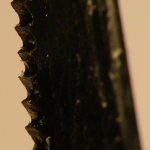Have you ever seen a prison movie where the inmate is sent a cake? You know what’s always hidden inside don’t you? The guards are oblivious of course and they deliver the present and quickly go back out to their station so as not to miss the game on TV. Then the inmate finds the file inside the cake and eventually cuts the bars and escapes to freedom. Who knew?
I’ve always thought this was a ridiculous tool to send a prisoner; the bars are an inch thick and a file would take forever. Why not send a hacksaw blade? I guess the prop guy could only find a file the day this part was shot and from there it just stuck and now all classic prison movies must include this scene.
What about a hacksaw blade as a tool for a pest control technician? I’m sure most would say that this is a useless thing to keep around and what would you be cutting anyway? Actually you wouldn’t be cutting anything but it can be used to find bugs that are otherwise beyond retrieve and that is always a benefit to a good tech.
I can’t remember where I learned about the usefulness of a hacksaw blade and perhaps it’s an old timers trick or maybe it’s just me because I don’t see anyone else using them. My tool belt always has one tucked away right next to my pocket magnifying glass. Whether you are a professional pest control inspector, technician or just a do it yourself bug man this may be something you’ll want to at least have on hand.
 Let’s face it some bugs are tiny and can go in super small cracks and crevices Evidence can also collect in these areas but without any way to extract it you may never know what bug your facing so without proper id you can’t really devise a good treatment strategy. I’ve shown you how to make your own bug collector and that may help but a hacksaw blade can reach deep into a crack and pull out otherwise non collectable evidence.
Let’s face it some bugs are tiny and can go in super small cracks and crevices Evidence can also collect in these areas but without any way to extract it you may never know what bug your facing so without proper id you can’t really devise a good treatment strategy. I’ve shown you how to make your own bug collector and that may help but a hacksaw blade can reach deep into a crack and pull out otherwise non collectable evidence.
These blades are ideal obviously because they are so thin but also because the teeth will grab an insect body or parts and if you are gentle enough you can bring it out of the tiny grave for the entire world to see. I’ve tried different ones and the best is a medium wood or metal blade because of its pointed sharp teeth. The course blades tend to be to thick and the fine cut although thinner doesn’t grab as much. You can also use the tool to ‘dig’ dead body parts or other evidence out but in any event I think you’ll be surprised at how well this device works. I’ve even hooked live worker termites and had them squirming and kicking trying to get of the teeth as I showed an unbelieving client.
Great places to use a hacksaw blade are gaps under window sills, garage door framework, cracks in cement, brick veneer, behind baseboards, behind wall mounted mirrors, cabinet gaps, expansion joints, in between 2×4’s and the list goes on and on.
Maybe you haven’t thought of using a hacksaw blade before or perhaps my writing hasn’t convinced you that this will work. That’s Ok there’s no punishment for your scoffing, I mean it’s not like you’re going to go to prison for it. Even if you did don’t fret, I know the perfect thing to send you.




